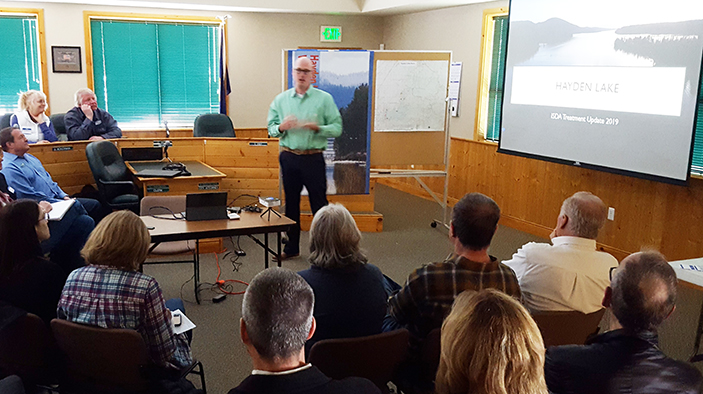On Thursday, March 7, Jeremey Varley from Idaho State Department of Agriculture presented ISDA’s Noxious Aquatic Weeds’ Department’s plans for treating Curly Leaf Pond Weed in Hayden Lake.
Standing-room-only greeted late-comers to the meeting, signaling the significant level of interest on the community’s part. Attendees appreciated the early-release of the treatment plan information as well as the opportunity to ask questions and express concerns over weed management.
Varley reviewed last year’s treatment:
- focused on Eurasian Watermilfoil
- treated shallow areas of shoreline all around the lake
- covered the entire North Arm of the lake

Forrest Walker pulls up anchor, overloaded with Curly Leaf, in May ’18.
ISDA follows the Idaho Noxious Weeds Rule when making decisions regarding what to treat and where. Curly Leaf Pond Weed is low on the priority list in that rule. But, in previous years’ treatments in the rich growing environment of the North Arm, Curly Leaf filled in behind the dying Milfoil before native vegetation could take hold. Further treatments, in 2019, for milfoil alone, would not address the whole problem. Therefore, ISDA has chosen a chemical treatment and timing that they expect to inhibit both Curly Leaf and Pond Weed. In Jeremey Varley’s words, “We want the native, natural environment to be able to recover on its own.”
What Chemical Will Be Used to Treat Weeds in Hayden Lake?
Planned are applications of a chemical herbicide whose active ingredient is Fluridone. It takes the form of a slow, time-release pellet. The contractor, Aqua Technex will apply it in concentrations well below Fluridone’s safety limit. The Fluridone targets Curly Leaf and will affect the emergence of Milfoil as well. The history of this chemical treatment indicates that there will be Curly Leaf next year, but less of it. And, while slightly stunted this year, next year’s recuperation of the native species will be stronger.
Lake-water use is a concern that impacts treatment decisions. ISDA selected Fluridone because it imposes no potable-water restrictions as long as the application rate is below 20 parts per billion (ppb). The planned application is 12 ppb at most, well below the maximum. There are irrigation restrictions: peppers and tomatoes are susceptible to the chemical above 5ppb, and all seedlings are vulnerable as well. Established crops are safe. To address this, they are targeting treatments at a time in the growing season when there is less water needed for gardening. A FASTest at each of 3 sites, once per treatment, will ensure the water is safe to use for gardening.
When Will Chemical Treatment Take Place?
Treatments will take place starting early May and will be repeated every three weeks for a total of three treatments. This treatment strategy gives the contact time needed for the chemical to penetrate the Curly Leaf plant system, including its turions. Its effect extends to the milfoil that is coming up behind the Curly Leaf. The next treatment phase will specifically target Milfoil and will take place in July IF surveys indicate the need.
Where will the treatments take place this spring?
Treatment will take place only in the North Arm area because that’s where seen the Curly Leaf was growing. Fall surveys of Mokins Bay did not reveal Curly Leaf in that bay. Treatments will follow the contours of the drop-off or shelf that separates the North Arm and the main body of the lake.
How Does Curly Leaf Pond Weed Spread?
Curly Leaf spreads in much the same way as Milfoil. That is, pieces of weed that break off when the water is agitated become rooted in the sediment at the bottom of the lake and grow. The small and buoyant fragments easily float to other areas of the lake. The dense, longer strands catch in motors, ropes, anchors, etc. so that boats easily carry them from one part of the lake to another. The weed requires shallow, warm water to thrive, so the shallower bays and shorelines quickly fall victim to either easily-spread species.
Curly Leaf also propagates via turions which are small pinecone-like structures that float freely and plant themselves in the shallow lake-bottom. They are hearty and can lie dormant for great lengths of time, sprouting later under favorable conditions.
What Other Questions Need to be Addressed?
Think of this session with ISDA as the beginning of the conversation. Learn more about Curly Leaf Pondweed via ISDA’s informational handout. Track treatment plans on the Invasive Species of Idaho website. If you have other questions or concerns, you may contact Jeremey directly at
Jeremey.Varley@isda.idaho.gov. Please also share your questions here. We will find answers for you and publish them in future posts.
[democracy id=”5″]



